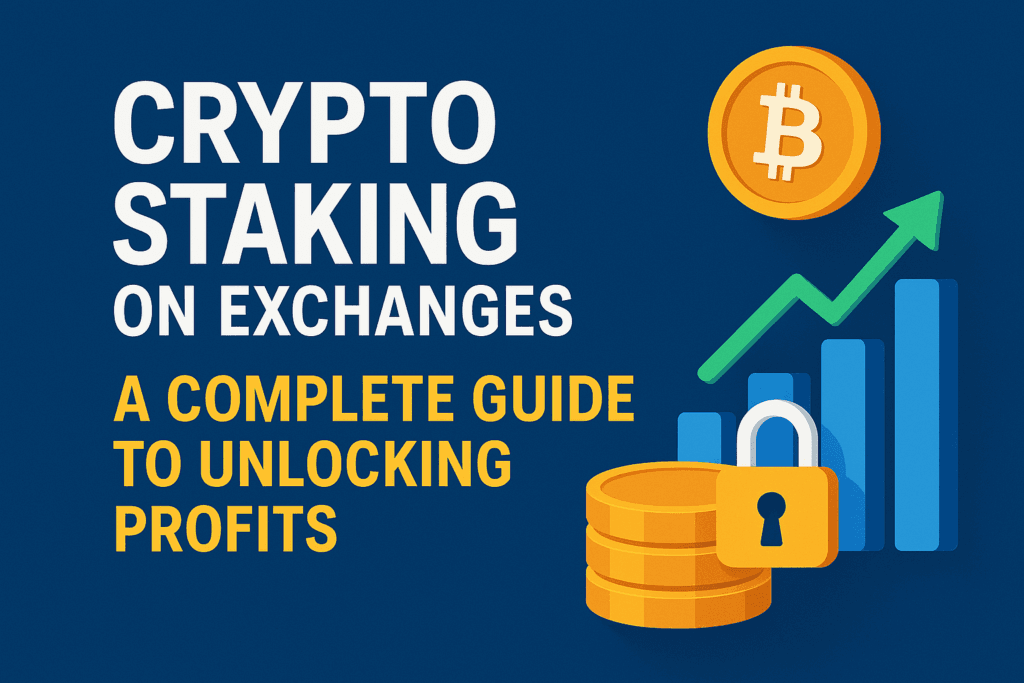Crypto Staking on Exchanges: A Complete Guide to Unlocking Profits
By expert

Crypto staking has emerged as one of the most effective ways to earn passive income in the blockchain space. Whether you’re a seasoned investor or a newcomer, understanding how to stake crypto on exchanges can help you maximize returns. In this complete guide, we’ll break down everything you need to know about staking, the best platforms to use, and tips to unlock consistent profits.
What is Crypto Staking? Crypto staking is the process of participating in the validation of transactions on a proof-of-stake (PoS) blockchain network by locking up your cryptocurrency. In return, you earn staking rewards. It’s similar to earning interest from a savings account but within the crypto ecosystem.
Learn more about PoS from Ethereum.org’s Proof-of-Stake Overview.
Why Stake on Exchanges? Staking on exchanges simplifies the process, especially for beginners. Instead of managing private nodes or wallets, exchanges handle the technical side for you. Plus, they often offer staking for multiple tokens with attractive annual percentage yields (APYs).
Types of Crypto Staking Options
- Flexible Staking: Withdraw anytime but lower APY.
- Fixed/Locked Staking: Higher APY with a commitment period.
- DeFi Staking: Earn via decentralized platforms, though riskier.
Best Crypto Staking Platforms Here are some of the top exchanges offering competitive staking rewards:
- Binance – Offers a wide range of staking products and high APYs. See Binance Staking Options.
- Coinbase – Ideal for beginners with an intuitive interface and support for major tokens like Ethereum. Explore Coinbase Staking.
- Kraken – Known for strong security and competitive rewards. Kraken Staking Features.
- OKX – Offers both flexible and fixed staking options. OKX Earn Program.
For more on choosing platforms, check out our blog on Best Crypto Staking Platforms.
How to Stake Crypto on Exchanges ?
- Choose an exchange that supports staking.
- Buy or deposit crypto you want to stake.
- Navigate to the staking section on the platform.
- Select a token, then choose fixed or flexible staking.
- Confirm and lock your crypto.
Crypto Staking Returns Snapshot Here’s a more detailed look at popular crypto staking options across leading platforms, including potential returns and lock-in periods:
| Token | Platform | APY (%) | Lock Period | Notes |
|---|---|---|---|---|
| Ethereum (ETH) | Binance | 4.5% | Flexible | ETH staking is tied to Ethereum 2.0 and may have temporary lock-up limits. |
| Solana (SOL) | Kraken | 6.2% | 14 days | Rewards are paid out bi-weekly; network uptime affects APY. |
| Cardano (ADA) | Coinbase | 3.8% | Flexible | ADA rewards auto-compound and are paid approximately every 5 days. |
| Polkadot (DOT) | OKX | 10.1% | 30 days | Higher APY with longer lock-up; DOT unbonding may take 28 days. |
| Avalanche (AVAX) | Binance | 5.4% | 15 days | Staking rewards depend on validator uptime and commission rate. |
Note: Rates vary based on network conditions and platform policies. Always verify APYs on the official exchange site before staking.
How to Choose the Right Token for Staking ?
- Look at the project’s long-term vision and use case.
- Check staking requirements and lock periods.
- Review the token’s market volatility and APY history.
Tips to Maximize Staking Profits
- Diversify your staking portfolio across multiple tokens.
- Choose longer lock-in periods if you’re not planning to trade short-term.
- Stay updated with tokenomics and protocol upgrades. A great resource is CoinGecko for real-time staking analytics.
- Use platforms with low fees to keep more of your earnings.
- Reinvest rewards to benefit from compound growth.
Explore more profit strategies in our post on How to Maximize Crypto Staking Rewards.
FAQs: Crypto Staking on Exchanges
Q1: Is staking crypto safe on exchanges? A1: Generally yes, but it’s important to use reputable exchanges with robust security measures.
Q2: What are the risks of crypto staking? A2: Market volatility, lock-up periods, and platform risk. Always do your research.
Q3: Which crypto is best for staking? A3: Ethereum, Solana, Polkadot, and Cardano are among the top choices.
Q4: Can I unstake anytime? A4: It depends on the platform. Flexible staking allows it, but fixed staking usually requires a commitment period.
Q5: How often are staking rewards paid? A5: Frequency varies by platform and token—daily, weekly, or monthly.
Conclusion Crypto staking on exchanges is a user-friendly way to grow your digital assets. By choosing the right platform and following best practices, you can unlock steady profits while contributing to blockchain networks. Whether you’re just starting or looking to enhance your staking strategy, this guide provides the tools you need for success.
Have any questions about staking or tried staking on any of these platforms? Drop your thoughts or tips in the comments below — let’s learn from each other’s experiences!

Leave a Reply